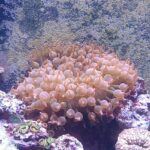Class Anthozoa, Order Alcyonacea, Family Alcyoniidae, Genera Sinularia, Sacrophyton, Lobophytum, Alcyonium, Cladiella, etc. Common names: leather coral, colt coral, toadstool/mushroom coral, tree coral, etc. Natural origin: Indo-Pacific Sensitivity (Level 1): These corals are usually exceptionally tolerant and forgiving. They’re also easy to fragment and propagate. Beware of dyed corals (pink leather corals have almost certainly… Read more »
Month: July 2016
Gorgonians
Gorgonians (Sea Fans and Sea Rods) Class Anthozoa, Subclass Octocorallia, Order Gorgonacea Common names: sea fans, sea rods Natural origin: Indo-Pacific Sensitivity (Level 3 to 5): Adaptability depends greatly on genera and species. Some (mostly the zooxanthellate species) can adapt to captive life with diligent, experienced care. Others (such the azooxanthellate species) will not survive… Read more »
Goniopora & Alveopora
Class Anthozoa, Order Scleractinia, Family Poritidae, Genera Goniopora and Alveopora Common names: flowerpot coral, daisy coral, ball coral Natural origin: Indo-Pacific Sensitivity (Level 4): Until very recently, it was thought that Goniopora were impossible to keep alive in captivity. Thanks to recent research, new food products, and valiant efforts by some aquarists, these corals can… Read more »
Xenia
Class Anthozoa, Order Alcyonacea, Family Xeniidae, Genus Xenia Common names: pulse coral, Xenia Natural origin: Indo-Pacific Sensitivity (Level 1): Though generally very easy to care for, these corals can be somewhat unpredictable. Some colonies show impressive tolerance and forgiveness of varying conditions while others do not. They are also notorious for sudden and unexplainable death… Read more »
Galaxea
Class Anthozoa, Order Scleractinia, Family Oculinidae, Genus Galaxea Common names: galaxea Natural origin: Indo-Pacific Sensitivity (Level 2 to 3): Though not beginner corals, they’re generally tolerant in healthy, established aquariums. Feeding: These corals should be fed a variety of smaller particle food. Lighting (Level 3 to 5): They can adapt to a range of lighting… Read more »
Zoanthids
Class Anthozoa, Subclass Zoantharia, Order Zoanthidea Common names: zoos, zoanthids, button polyps (sometimes inconsistently given names like “fire and ice” and “people eaters” based on phenotypic characteristics such as coloration and size that may have little or nothing to do with actual species identification) Natural origin: wide-ranging, Indo-pacific Sensitivity (Level 1): Zoanthids are usually quite… Read more »
Fungiidae
Common names: disc coral, plate coral, tongue coral, fungia, mushroom coral Natural origin: Indo-Pacific Sensitivity (Level 1 to 3): Sensitivity depends on genus and species. Species from the genus Fungia are generally tolerant and tend to have excellent success rates among aquarists. Heliofungia species (often distinguished by their long tentacles) have a reputation for being… Read more »
Turbinaria
Class Anthozoa, Order Scleractinia, Family Dendrophylliidae, Genus Turbinaria Common names: pagoda cup coral, turban coral, vase coral Natural origin: Indo-Pacific Sensitivity (Level 1 to 2): These corals are generally tolerant, forgiving and without much need for specialized care. Always avoid purchasing dyed corals. Feeding: Turbinaria spp. have medium-sized polyps and good prey capture ability. They… Read more »
Favia and Favites
Favia and Favites (and other moon corals) Class Anthozoa, Order Scleractinia, Family Faviidae, Genera Favia and Favites Common names: moon coral, brain coral Natural origin: Indo-Pacific Sensitivity (Level 1 to 2): Sensitivity depends a bit on the species, but most are quite tolerant, forgiving and easy to care for. Feeding: Most species have considerable prey… Read more »
Bubble Coral

Plerogyra and Physogyra (Bubble Coral) Class Anthozoa, Order Scleractinia, Family Euphyllidae, Genera Plerogyra and Physogyra Common names: Bubble coral Natural origin: Indo-Pacific Sensitivity (Level 2): These are generally tolerant, forgiving corals. Feeding: Bubble corals, with their exceptionally strong prey capture ability and large polyp mouths, can easily feed on chunky, meaty sea foods. Despite their… Read more »
